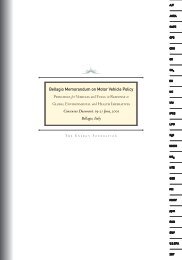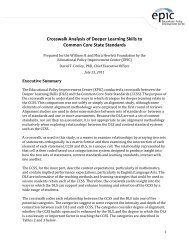EDUCATION FOR LIFE AND WORK - Hewlett Foundation
EDUCATION FOR LIFE AND WORK - Hewlett Foundation
EDUCATION FOR LIFE AND WORK - Hewlett Foundation
Create successful ePaper yourself
Turn your PDF publications into a flip-book with our unique Google optimized e-Paper software.
Education for Life and Work: Developing Transferable Knowledge and Skills in the 21st Century<br />
26 <strong>EDUCATION</strong> <strong>FOR</strong> <strong>LIFE</strong> <strong>AND</strong> <strong>WORK</strong><br />
is poor. In psychometric modeling, constructs viewed as separate from their<br />
measures are referred to as latent (as opposed to observed or measured)<br />
variables. There are two types of latent variables: reflective latent variables<br />
and formative latent variables (see Figure 2-1).<br />
Following a concept proposed by Spearman (1904, 1927), a reflective<br />
latent variable is identified based on correlations among scores from a<br />
set of tasks. Differential psychologists discover reflective latent variables<br />
using factor analysis and related methods to identify the patterns of correlations<br />
among a set of “indicator variables”—scores on tests and rating<br />
instruments used to measure cognitive and noncognitive competencies. A<br />
reflective latent variable—such as general cognitive ability or one of the<br />
“big five” personality factors (McCrae and Costa, 1987)—is thought to<br />
reflect the essence of, or the commonality among, the various competencies<br />
measured. In psychometric modeling, a reflective latent variable (also called<br />
a factor because it is discovered through factor analysis) is said to cause<br />
the relationships among the set of indicator variables (see Figure 2-1). For<br />
example, extraversion, a personality factor, is thought to cause relatively<br />
high scores on instruments measuring warmth, gregariousness, and assertiveness.<br />
Within a reflective latent variable, the importance or weighting of<br />
an individual indicator variable is a function of how highly that particular<br />
indicator variable correlates with other indicator variables for the reflective<br />
latent variable (Bollen and Lennox, 1991).<br />
Reflective<br />
Formative<br />
FIGURE 2-1 Casual structures in reflective and formative latent variables.<br />
SOURCE: Stenner, Burdick, and Stone (2008). Reprinted with permission.<br />
Figure 2-1<br />
Copyright © National Academy of Sciences. All rights reserved.
















